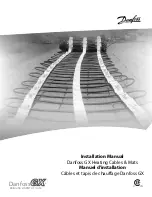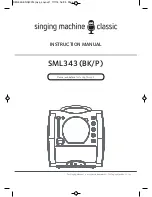
Set up for Stick Welding (SMAW)
Electrode
Polarity
Usage
E7018, E6011, E6013
DCEP
This electrode is best for use with clean, bare steel and is suitable for moderate
penetration.
E6010
DCEN
This electrode is usually used for building up heavy deposits of materal with less
penetration and thin sheet welding.
Electrode Size ø mm/Inch
Current Range (Amps)
3/32" or 0.09" (2.4mm)
60~95
1/8" or 0.125" (3.2mm)
100~130
11/64" 0r 0.15" (4.0mm)
130~165
13/64" or 0.19" (5.0mm)
165~260
- 24 -
Ÿ
Remove the Wire Drive Polarity Lead form the POSITIVE (+) or NEGATIVE (-) SOCKETS (Remove the MIG torch at the
same time).
Ÿ
Check the electrode packaging to determine the recommended polarity and connect the electrode stringer and work clamp
to the POSITIVE (+) or NEGATIVE (-) SOCKETS accordingly.
Ÿ
Place the electrode into the electrode holder firmly.
Ÿ
Ensure the work clamp has good contact with the workpiece on a clean, bare metal surface free of rust, paint, or coating.
Note: For Stick welding, DCEP means the electrode holder is connected to the positive socket while the work
clamp (workpiece) is connected to the negative socket.
However, various electrodes require a different polarity for optimum results. Please follow the electrode
manufacturer’s recommendation on the correct polarity.
Ÿ
Turn the power source on and select the Stick function with Process Selection Button on the front panel.
Ÿ
Set the amperage with the Adjustment Knob (1).
Ÿ
Strike the electrode against the workpiece to create an arc and hold the electrode steady to maintain the arc.
Ÿ
Hold the electrode slightly above the work, maintaining the arc while traveling at an even speed.
Ÿ
To finish the weld, break the arc by quickly snapping the electrode away from the workpiece.
Ÿ
Wait for the weld to cool and carefully chip away the slag to reveal the weld metal below.
Welding Current Guide
Choosing the correct current for a particular welding job is critical. If the welding current is too low, the user will experience difficulty
in striking and maintaining a stable arc. The electrode tends to stick to the workpiece, penetration is poor, and the weld ends up with
a rounded profile. If the current is too high, the problems include burning through the base metal, undercut, and excessive spatters.
The standard welding current for a particular job should be the maximum that won’t burn through the base metal, overheat the tung-
sten electrode, or leave spatters sticking to the workpiece surface.
The table shows current ranges generally recommended for a general purpose type E6013 electrode.
In SMAW mode, the user can adjust four parameters directly. The description is as follows:
VRD Optional:
The VRD feature is not embedded in the welder. It’s available as an option. A voltage reduction device (VRD) is a hazard reduction
device that lowers the welder’s open circuit voltage (OCV) to prevent electric shock from welding current. A VRD is usually
equipped with a stick welding machine in wet environments or conductive confined spaces. The designated open circuit voltage
(OCV) is not present before the electrode touches the workpiece. Instead, a low voltage for sensing purposes is presented between
electrode and workpiece. It allows the electrode to touch the workpiece without overheating, sticking, or contamination.
Summary of Contents for YWM-211P
Page 2: ......
Page 38: ...WIRING DIAGRAM 34...
Page 39: ......
Page 40: ...WE ALWAYS STAND BEHIND IT Toll Free 855 937 4567 www yeswelder com...













































